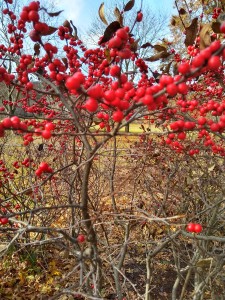
I was reminded of two things—I have coveted winterberry holly for years and never managed to acquire one for my own garden, and I have an ongoing need for more winter color overall. To my mind, the best color comes from shrubs and trees with berries that persist through the winter. In addition to lifting spirits and beautifying a sometimes barren landscape, berried shrubs also act as food plants for overwintering birds. Bright fruits attract bright birds, and there is nothing better on a winter morning than seeing a brilliant red male cardinal loitering on the premises.
Winterberry holly is also sometimes known as black alder, coralberry and Michigan holly. Unlike evergreen hollies, winterberry loses its non-prickly leaves in the fall, the better to show off those scarlet berries. Left to its own devices in its native eastern United States, winterberry holly will grow six to ten feet tall and wide. Cultivated varieties are generally smaller and can be pruned to keep them in proportion to their surroundings. I have seen winterberries massed in a nearby park, and they are dramatic, especially in December. Flower arrangers often use them in winter displays as well.
As with many other hollies, you need to invest in two specimens–a male and a female—to produce the lovely fruits. Fortunately, plant tags and nursery personnel can usually provide this information. Sometimes the name helps. For instance, ‘Southern Gentleman’ is, as you might expect, a male holly. So is ‘Rhett Butler’. Fortunately, either male can form a productive relationship with the lovely female ‘Scarlett O’Hara’.
Winterberry is only one of the beautiful, widely available members of the populous Ilex clan. If you are lucky enough to have some of the evergreen hollies in your garden, you probably already appreciate their contributions to the winter landscape. The bright red berries are a hit at holiday time and the glossy leaves shine year round. As with winterberries, if your holly does not bloom, either it is a lonely female, a lonely male, or it has been pruned at the wrong time, eliminating the flowers that eventually give way to the berries.
Rose family members often boast beautiful fruits. Some shrivel when frost comes, but others persist through the winter. The red chokeberry or Aronia arbutifolia is a multi-stemmed shrub that tops out at about eight feet tall. Native to eastern North America, chokeberry has a decorative nature that makes it easy to like. In the spring the shrub sports clusters of small pinkish-white flowers. Each one has five petals and looks like a small wild rose. In late spring and summer, finely-toothed, ovoid leaves continue the work of beautifying the chokeberry. These turn a glorious red shade in the fall, before dropping to reveal the berries in all their glory. Loved by birds and wildlife, the aronia fruits are small and extremely sour, hence the “choke” part of the common name. If you are a wild food enthusiast, you can collect them, add a sweetening agent and turn them into jams or baked goods. I prefer to leave the berries on the shrub to feed the birds to do decorative duty through the winter.
Crabapple or malus varieties are also members of the rose family. Most people buy them for the glorious spring flower show, but four-season gardeners know that most commercially available varieties also set colorful, long-lasting fruit. If you have enough space, install two flowering crabs, one that bears red “apples”, and another, like ‘Autumn Treasure’ or ‘Brandywine’ that produces yellow or gold autumn fruit. In winter the little crab apples hang like jewels on the trees.
If you have ever pruned a Pyracantha coccinea, or scarlet firethorn shrub, without gauntlets, you have felt the pain that comes with this highly decorative plant. Firethorn is another member of the rose family and is generally well-armed with long spines, making it great for boundary hedges, privacy barriers and other situations where excluding humans or animals is necessary. You can also train the rambunctious, fast-growing stems up arches, tall trellises or sturdy walls.
Pyracanthas are a little like brilliant, fractious teenagers. The best outcomes are usually the result of gentle but persistent supervision and discipline. Pruning is a must if you don’t want your firethorn to end up as a 30 by 25 foot raging inferno. To ensure that you will end up with a reasonable-size plant and plenty of berries, prune after flowering in the spring. In slightly warmer climates, pyracantha may be evergreen or semi-evergreen. A well-tended firethorn shrub with exuberant berries is a lovely sight in November and December, by which time you will have forgotten the pain of pruning the thorny canes.
Winter is the time to seek comfort where you can find it, snuggling into warm sweaters and cozy living spaces.. Outside, consider generating some heat with the flames of bright berries.
